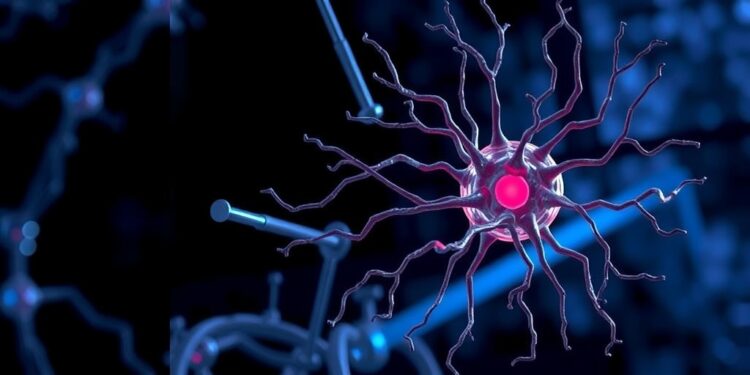Parkinson’s disease (PD) and Lewy body dementia (LBD) present serious challenges both to individuals grappling with these neurodegenerative disorders and to the neuroscientific community seeking effective treatments. Often confused due to overlapping symptoms, PD and LBD are distinct conditions characterized by an accumulation of Lewy bodies, which are aggregates made up primarily of α-synuclein proteins. The complexity of these diseases, which respectively affect millions globally, raises urgent questions about their underlying mechanisms and potential paths for therapeutic intervention.
Recent research spearheaded by HE Zhuohao’s team from the Shanghai Institute of Organic Chemistry sheds light on a crucial but often overlooked aspect of Lewy body pathology: the “fuzzy coat” surrounding the rigid core of α-synuclein fibrils. Traditionally, the focus has rested heavily on the stable core of these aggregates, leaving the more dynamic fuzzy coat largely unexplored. However, in a groundbreaking study published in the journal Neuron, this research team reveals that the flexibility and structure of the fuzzy coat play a vital role in the transmission of pathological proteins in synucleinopathies.
The team adopted a serial amplification technique to simulate the in vivo process of pathological protein transmission effectively. This approach allowed them to differentiate between two structural variants, categorized as Mini-P and Mini-S. The Mini-P variant, characterized by a more compact fuzzy coat, demonstrated heightened neuronal seeding activity compared to the more loosely arranged Mini-S variant. The implications of this discovery extend beyond basic science; they suggest that the nuanced structural details of α-synuclein fibrils could significantly affect how these proteins propagate within the nervous system.
Employing an array of advanced structural biology methods, including cryo-electron microscopy, solid-state nuclear magnetic resonance, and hydrogen/deuterium exchange mass spectrometry, the research team detected dynamic differences in the fuzzy coats of the two polymorphs. Although both Mini-P and Mini-S fibrils share remarkably similar rigid cores, it is the unique characteristics of their fuzzy coats that determine their ability to transmit pathological signals between neurons.
Interestingly, the researchers ascertained that the greater neuronal seeding capacity of Mini-P fibrils is partly due to the compact nature of its fuzzy coat, which effectively shields certain negative charges. This shielding reduces the repulsion experienced by neuronal receptors, particularly heparan sulfate proteoglycan (HSPG). By minimizing this repulsive force, Mini-P aggregates can be absorbed more efficiently by neurons, consequently enhancing their transmission capabilities and resistance to proteolysis.
The findings not only contribute to our understanding of the molecular mechanisms underpinning the spread of neurodegenerative pathology but also identify new targets for potential therapeutic interventions. Given the complexities of managing neurodegenerative diseases, targeting the fuzzy coat may provide a more innovative and viable tactic than attempting to eliminate all pathological protein aggregates, a process that is both energy-intensive and fraught with complications.
By disrupting the intricate interactions between the fuzzy coat and the fibril core, it could be possible to interfere with the transmission efficiency of these aggregates. The prospect of slowing disease progression by altering the structural integrity of the fuzzy coat presents a compelling new avenue for drug development. Such a targeted approach could minimize side effects while maximizing the therapeutic impact on patients suffering from PD and LBD.
Validation of the research model using conformation-specific antibodies revealed that these agents can differentiate between Mini-P-like and Mini-S-like pathological proteins in human brain tissues, confirming the relevance of the findings in vivo. This connection between in vitro observations and human disease indicates promising pathways for clinical applications, substantiating the role of subtle structural variations in influencing the pathogenicity of neurodegenerative diseases.
This research marks a pivotal moment in the exploration of neurodegenerative diseases. The revelation of the fuzzy coat’s significance underscores the need for a shift in focus within the field. By moving beyond the rigid structure of α-synuclein fibrils, researchers are now equipped to unravel the more intricate and nuanced aspects of protein aggregation and transmission.
Moreover, these insights may aid in designing more effective strategies for intervention, informing both pharmaceutical research and clinical practice. The potential for developing therapies that specifically target the fuzzy coat could revolutionize treatment approaches for neurodegenerative conditions and ultimately improve the quality of life for millions affected by these relentless diseases.
In summary, the intricate dance of proteins that manifests in neurodegenerative diseases is now better understood, thanks to pioneering research that spotlights the fuzzy coat of α-synuclein fibrils. As neuroscience continues to evolve, this newfound emphasis on the dynamic nature of these pathological proteins offers hope for innovative therapies that could alter the course of diseases like Parkinson’s and Lewy body dementia. The implications of this research extend beyond academia, cultivating optimism that effective treatments could soon be on the horizon.
As we look towards the future, one can only hope that these groundbreaking insights will spur further investigations and collaborations that unlock the mysteries of neurodegeneration, leading to a holistic understanding of these diseases and the development of life-altering interventions.
Subject of Research: The role of the fuzzy coat of α-synuclein in pathological transmission in neurodegenerative diseases.
Article Title: Fibril fuzzy coat is important for α-synuclein pathological transmission activity.
News Publication Date: 10-Apr-2025.
Web References: Link to Neuron Article.
References: Neuron, DOI: 10.1016/j.neuron.2025.03.019.
Image Credits: Shanghai Institute of Organic Chemistry.
Keywords
Fibrils, α-synuclein, Parkinson’s disease, Lewy body dementia, neurodegeneration, fuzzy coat, neuronal transmission, synucleinopathies.




